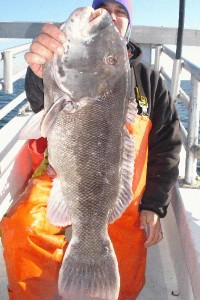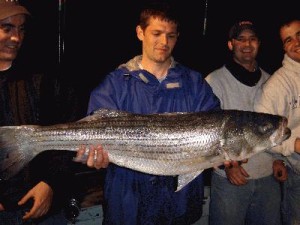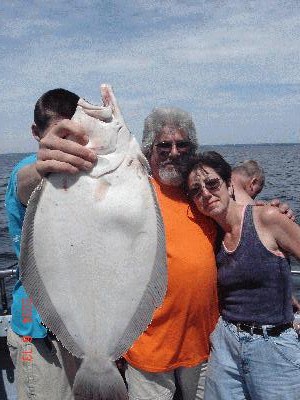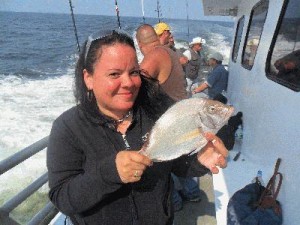
Capt. Chris – 13lb BLACKFISH
BLACKFISH / TAUTOG
A territorial fish found on hard-bottom reefs, rockpiles, sunken wrecks, and inshore mussel beds. The Long Island Sound is a fantastic area to catch gigantic blackfish both in the spring and fall. In the spring the tautog are caught in the shallow water and during the fall run the tautog are caught in deep water up to 90 feet deep. These critters frequent rock piles, bridge pilings, artificial reefs and old wrecks. They feed on a variety of mollusks and crustaceans such as mussels, barnacles, and crabs, which the fish crushes in its strong molars. Tautog are extremely fun to catch and even better to eat!

Sea Bass / Purple Warrior
The sea bass is a member of the family Serranidae, or tru sea basses. Also known in the Long Island Sound area as “Purple Warrior”. They are year-round inhabitants of the mid-atlantic region. The sea bass are a bluish-black fish as adults and brown as juveniles. They have scales with pale blue or white centers. The black sea bass population extends from Maine to the Florida Keys and into the Gulf of Mexico. Adult black sea bass are considered a temperate reef fish, and are most often found on rocky bottoms near pilings, wrecks and jetties. A visual feeder during daylight hours, Black Sea Bass rely on swift currents and their large mouths to capture their prey. their prey include other fish, crabs, sandworms, mussels and skimmer clams. Although they do not travel in schools, they can be found in large groups around structures or during in-shore / off-shore migrations. In the Long Island Sound we usually catch these fish mixed in while porgy fishing. The Sea Bass is perhaps one of the best eating fish.

Flounder / Blackback / Lemon Sole
The winter flounder, black back, or lemon sole, Pseudopleuronectes Americanus, is distributed in the Northwest Atlantic from Labrador to Georgia. Window flounder may attain sizes up to 25 inches total length. Their diet consists primarily of Benthic Invertebrates. The bait most people prefer includes sandworms, bloodworms mussels, and skimmer clams. Movement patterns are generally localized. Winter flounder undertake small-scale migrations into estuaries, embayments and saltwater ponds in winter to spawn, subsequently moving to deeper water during summer. Winter flounder tend to return to the same spawning locations in consecutive years. Flounder fishing is generally done in calm sheltered waters. This is a clam and relaxing fish to catch and great for children and beginners.

Striped Bass / Stripers
The striped bass is actually a member of the temperate bass family. Stripers are the largest species in the Bass family. It is a much sought-after sport fish and heartily takes a wide variety of artificial lures and live baits. A long, silvery fish with 7-9 distinct lines running length-wise along sides and back. Sharp spine on gill cover. Teeth on the base of the tongue are arranged in parallel patches. Native to the Atlantic Ocean and its coastal tributaries. Striped Bass prefer large bodies of deep, cool water. Moss bunker, herring and mackerel are the most productive baits. Jigs, jigging spoons and crank baits are good lures. Trolling with large, deep diving crank baits can also be effective.

Fluke / Summer Flounder / Doormat Fluke
A popular flatfish both in the United States and overseas, Summer Flounder or Fluke, are found in then Western Atlantic from Maine to South Carolina. The best season in the Long Island Sound is from may until August. Summer Flounder is similar to Winter Flounder in both flavor and appearance. However, it is considerably larger in size, averaging 3-12 pounds. The Fluke enjoy feeding on spearing, snappers, killies, squid, mackeral and peanut bunker. Many of the “sharpies” use bucktails to catch Doormat Fluke. Let Captain Chris know if you would like to use one of his custom bucktailing rods. The technique used for Fluke fishing is strictly drift fishing.

Porgy is a common name for this fish, which is important to commercial and recreational fishermen. Anglers enjoy catching SCUP because they put up a fight. This fish is a dull, silvery color, iridescent with a white belly and its sides and back are flecked with blue and marked with 12-15 indistinct longitudinal stripes. Scup have a deep body which is flattened sidewise. Their scales are large and firmly attached. Adult Scup average 14-16 inches and 1-2 pounds. During the summer months the scup stay close to shore, to the bottom and concentrate over areas of smooth to rocky bottom. This results in a congregation in some areas and complete absence in other nearby areas. Scup feed on small, bottom-dwelling invertebrates (crabs, clams, sandworms, bloodworms, squid and skimmer clams. Scup can grab food with their front teeth and then crush hard-shelled animals with their molars. They travel in schools and migrate offshore and southward in the fall.

